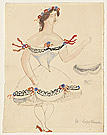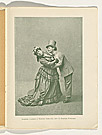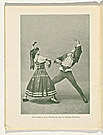La Boutique Fantasque
Ballet in one act
- Producer: Les Ballets Russes de Serge Diaghilev
- Premiere: 5 June 1919, Alhambra Theatre, London
- Costume design: André Derain
- Scenery design: André Derain
- Music: Gioacchino Rossini, arranged and orchestrated by Ottorino Respighi
- Choreography: Léonide Massine
- Libretto: Serge Diaghilev, Léonide Massine, Serge Grigoriev, André Derain, after Puppenfee(The fairy doll) by Josef Bayer
- Main characters: The Shopkeeper, the Shopkeeper’s Assistant, Cancan dancers, the Tarantella dancers, the Brown Poodle and the White Poodle, the Russian Merchant Family, the American and his Wife, the English ladies, the Queen of Clubs, the Queen of Hearts, the King of Spades, the King of Diamonds, the cossacks
This ballet is set in a toyshop. As it opens, an English lady, an American family and a Russian family enter to peruse its wares. The many mechanical toys and dolls—Tarantella dancers, street vendors, kings and queens from a pack of playing cards, poodles, Cossacks and two cancan dancers—are demonstrated to the customers by the owner of the shop. As the shop shuts for the day, many of the dolls are purchased by the various shoppers. The toys then come to life and lament the fate of the two cancan dancers, who are lovers and who will be sent to different families the next day. The toys devise a plan to allow the dancers to escape together. The next day the owner is confronted by the angry customers who claim that their parcels of toys have not been delivered as promised and are now only empty boxes. A ruckus ensues among the angry customers and the remaining toys return to life, with the cossacks chasing the customers from the shop and all celebrating with the Shopkeeper at this outcome.
Set in the period of the 1860s, this ballet is a re-working of a popular Viennese ballet, Die Puppenfee (The fairy doll) of 1888, which had been revived by Serge and Nicholas Legat in St Petersburg early in the twentieth century.5 Diaghilev, stimulated by Respighi’s discovery of Les Riens (Trifles), a suite of piano pieces by Rossini, was inspired to commission Respighi to arrange these works for La Boutique fantasque.6 Bakst had expected to be commissioned by Diaghilev to design the ballet but a misunderstanding led to Diaghilev instead commissioning André Derain who, despite having no theatre experience, brought the freshness of his Fauvist painting to the task and a new connection for Diaghilev to the world of contemporary painters. Derain’s light and elegant painterly approach to the set and the costumes for a variety of engaging characters brought the stage to life and enhanced Massine’s staccato choreography for the mechanical toys. Derain’s designs were presented as oil sketches, showing little concern for the technical details of the costumes. The popular comedic figures of the dancing poodles were costumed to resemble actual toys, a triumph of the costumiers’ skills in interpreting Derain’s sketches. Like worn teddy bears today, they retain their tattered charm.



![André DERAIN | Curatin decoration for La Boutique Fantastique [Rideau de fond du décor de La Boutique Fantastique] | 1919-20](images/sml/203480.jpg)




![André DERAIN | Model for the decoration for La Boutique Fantastique [Maquette du décor de La Boutique Fantastique] | 1919-20](images/sml/203481.jpg)

![Pablo PICASSO | Curtain design for La Boutique Fantastique [Esquisse du rideau de La Boutique Fantastique] / Set for Le Tricorne [Décor du Le Tricorne] | 1919-20](images/sml/203485.jpg)

